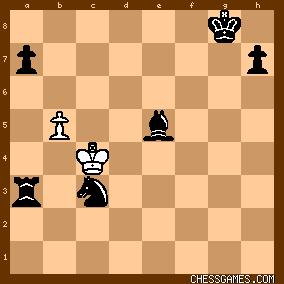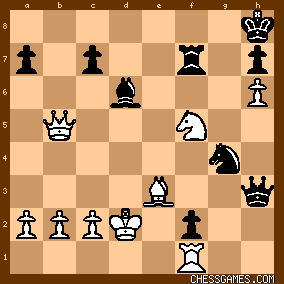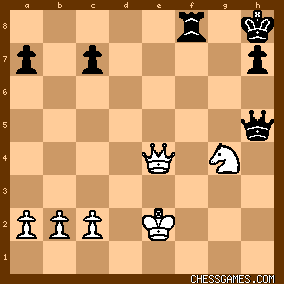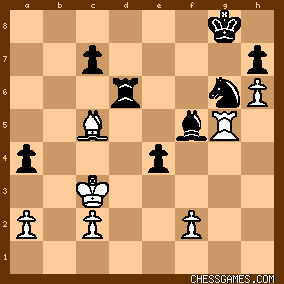| Jul-04-09 | | WhiteRook48: 3...d6 is too passive |
|
| May-25-20 | | carpovius: What if 33... Re7+? |
|
| May-25-20 | | Granny O Doul: On 33...Re7+ any king move will lose to either...Qh3+ or ...Re1+. So that leaves 34. Ne6+ when after ...Kg8 White seems to be losing a piece for nothing. I realize that this raises other questions, but of the answers to them I have no idea. |
|
| May-25-20 | | Brenin: White was in trouble from 24 Qxc3 e3 onwards (24 Bxg5 e3 25 Bxe3 was much better), with the resulting P on f2 a real thorn in his side. Did Black lose on time, or not see that after 33 ... Re7+ 34 Ne6+ Kg8 he was safe from the mating threats of Qb8+, and in fact in a winning position, about to capture the N on e6? |
|
May-25-20
 | | AylerKupp: <Granny O Doul> After 33...Re7+ Stockfish 11 indicates that Black has a won game, with anything other than 34.Ne6+ leading to a forced mate. And after 34.Ne6+ it evaluates the position at [-15.68], d=39 (it was even more favorable to Black at lower plies) after 33...Kg8 34.Kd3 c5 35.Rxf2 Rxe6 36.Re2 Qh3+ 37.Kc4 Qf1 38.Kb3 Qxe2 39.Qxe2 Rxe2 40.Bc3 Ne3 41.Ka3 Rxc2 42.Ka4 Re2 43.Kb5 Nd5 44.Ba5 Bc7 45.Be1 Rxe1 46.Kxc5 Ra1 47.a3 Be5 48.b4 Nc3 49.Kc4 Rxa3 50.b5

click for larger viewMany questionable moves by both sides in that line but it's clear that White is lost after 37...Qf1 or even earlier. Perhaps, as <Brenin> remarked, Black might have lost on time. If not, yet another justification of the maxim that no one ever won a game by resigning. |
|
May-26-20
 | | NM JRousselle: Did Black lose on time? |
|
| May-26-20 | | carpovius: <AylerKupp> what do you want to show us with the analysis? Is it not clear that White must resign after 33...Re7+? |
|
May-26-20
 | | AylerKupp: <carpovirus> Sorry about that. I often get frustrated when someone posts something like "the engine says that this is a win for ..." and no additional information. What engine? What was the evaluation and at what search depth was that evaluation calculated? Often posters will only let engines, particularly Stockfish, calculate for a very short time and Stockfish's evaluation are not very reliable at low plies. Besides, if I don't show the engine's analysis and just agree that Black wins after 33...Re7+ then someone might not find it obvious and take you to task for not showing the win. On the other hand, if I do show the engine analysis then I'm taken to task for stating the obvious. So I think that this is one of those situations when you just can't win. Oh well. But that brings up some interesting questions. I suppose that if it is that obvious that Black wins after 33...Re7+ then it supports the suggestion that Black lost on time, otherwise he would have played it. Then that raises the question, would Tal have resigned after 33...Re7+? It should have been obvious to him that he was lost. But maybe Tal was also short of time. Was there any move he could have made after 32...Qxh6+ besides 33.Ke2 giving Black a tempo with 33...Re7+ that might have allowed him to save the game? Not according to Stockfish 11, White was lost after 32.Bd4 Qxh6+ also. So maybe 32.Bd4 was the losing move since it allowed 32...Qxh6+ and that might not have been obvious to Tal because he was (also?) short of time. But no, Stockfish indicates that White was lost after what it considered to be White's best move in this position, 32.Nf5.

click for larger viewStockfish evaluates the position after 32.Nf5, d=40 at [-4.49] also lost for White after 32...33.Nxe3 Qxh6 34.Qd5 Rf6 35.Kd3 Bf8 36.Qe4 Qh5 37.Ng4 Rd6+ 38.Ke2 Rd8 39.Rxf2 Re8 40.Rxf8+ Rxf8.

click for larger viewBlack is the exchange up and White's king does not look too safe. And, with the time control reached, Black's likelihood of blundering are reduced. |
|
| May-26-20 | | Charlie Durman: <<NM JRousselle: Did Black lose on time?>> Tal won
Black lost.
The numpties on ere will ride it out ... |
|
May-26-20
 | | AylerKupp: <carpovirus> But this discussion made me wonder, usually a bad thing. Where did White go wrong? Doing a binary-like search, the 1st column indicates Black's move, the 2nd column indicates White's actual move, the 3rd move indicates Stockfish's top move, and the 4th and 5th columns indicate the search depth and evaluation of Stockfish's 3rd best move in column 3. <carpovirus> But this discussion made me wonder, usually a bad thing. Where did White go wrong? Doing a binary-like search, the 1st column indicates Black's move, the 2nd column indicates White's actual move, the 3rd move indicates Stockfish's top move, and the 4th and 5th columns indicate the search depth and evaluation of Stockfish's 3rd best move in column 3. 30...Ne5 31.Qd5 <31.Qd2> 31 [-4.97] 14...d5 15.Nf5 <15.exd5 38 [+2.80]
22...b4 23.Bxd8 <23.Bxd8> 39 [+3.55] 26...exf2 27.Qc4 <27.Qc4> 35 [-4.49] 24...e3 25.Bxg5 <25.Bxg5> 39 [-4.49] 23...bxc3 24.Qxc3 <24.Bxg5> 36 [+3.79] Or, in move order:
14…d5 15.Nf5 <15.exd5> 38 [+2.80] 22…b4 23.Bxd8 <23.Bxd8> 35 [+3.55] 23…bxc3 24.Qxc3 <24.Bxg5> 36 [+3.79] 24…e3 25.Bxg5 <25.Bxg5> 39 [-2.60] 26…exf2 27.Qc4 <27.Qc4> 35 [-4.49] 30…Ne5 31.Qb5 <31.Qe2> 39 [-4.97] So, as far as Stockfish is concerned, White had a won game but after 24.Qxc3 White surprisingly had a lost game. By 25.Bxg5 he would have kept his winning advantage. What did Tal overlook or was he already short of time at this point? At any rate, a fun game. The game might have continued: 24...cxb2+ 25.Kb1 (as often happens, White's king is protected by Black's advanced P2) 25...Ba4 26.Qd5 Qc6 27.Qxc6 Bxc6 28.Be3 (now Black doesn't get his advanced Pf2 and does not capture White's Rh1, remaining the exchange down, although the 2 bishops give him some attacking chances) 28...Ng6 29.Rh5 Rd7 30.Ne6 Kf7 31.Nc5 Re7 32.Bd4 Re8 33.Rf5+ Kg8 34.Rg1 a5 35.Kxb2 (with queens gone the Pb2's protection is no longer needed) 35... a4 36.Rfg5 Kf7 37.Kc3 Rf8 38.Kc4 Be7 39.Rf5+ Kg8 40.Re5 Bd6 41.Reg5 Re8 42.Kc3 Bxc5 (a questionable exchange, IMO; White's Nc5 doesn't have any worthwhile squares to attack and Black loses the 2 bishops, although the BOC might give Black some drawing chances) 43.Rxc5 Re6 44.Rf5 Rd6 45.Rgg5 Bd7 46.Bc5 Bxf5

click for larger viewThis is where Stockfish's analysis stops, although the likely continuation is 47.Bxd6 Be6 48.Bxc7 Bxa2 49.Ra5 and Black's a-pawn is a goner. White will be the exchange and a pawn up and should win without too much difficulty. So, as far as Stockfish is concerned, White had a won game but after 24.Qxc3 White surprisingly had a lost game. By 25.Bxg5 he would have kept his winning advantage. What did Tal overlook or was he already short of time at this point? At any rate, a fun game. The game might have continued: 24...cxb2+ 25.Kb1 (as often happens, White's king is protected by Black's advanced P2) 25...Ba4 26.Qd5 Qc6 27.Qxc6 Bxc6 28.Be3 (now Black doesn't get his advanced Pf2 and does not capture White's Rh1, remaining the exchange down, although the 2 bishops give him some attacking chances) 28...Ng6 29.Rh5 Rd7 30.Ne6 Kf7 31.Nc5 Re7 32.Bd4 Re8 33.Rf5+ Kg8 34.Rg1 a5 35.Kxb2 (with queens gone the Pb2's protection is no longer needed) 35... a4 36.Rfg5 Kf7 37.Kc3 Rf8 38.Kc4 Be7 39.Rf5+ Kg8 40.Re5 Bd6 41.Reg5 Re8 42.Kc3 Bxc5 (a questionable exchange, IMO; White's Nc5 doesn't have any worthwhile squares to attack and Black loses the 2 bishops, although BOC might give Black some drawing chances) 43.Rxc5 Re6 44.Rf5 Rd6 45.Rgg5 Bd7 46.Bc5 Bxf5

click for larger viewThis is where Stockfish's analysis stops, although the likely continuation per Stockfish is 47.Bxd6 Be6 48.Bxc7 Bxa2 49.Ra5 and Black's a-pawn is a goner. White will be the exchange and a pawn up and should win without too much difficulty. |
|
May-26-20
 | | harrylime: Tal won
live with it 😊😊😊😎 |
|
| May-27-20 | | carpovius: <AylerKupp> I believe get your points. In any ocassion I prefer human analysis to machine one. Otherwise questions arise: am I discussing with a person or engine? Is a kibitzer like you protein or silicon kind? Etc. |
|
| May-27-20 | | Granny O Doul: A little research shows Tal and Karner meeting in a 1976 event in Tallinn where each player had thirty minutes for the game. So a time forfeit in a winning position is not so surprising. |
|
| May-27-20 | | carpovius: 30 min per game... Strange time limit. |
|
| May-27-20 | | Brenin: Thanks, <Granny O Doul>, that explains some very uneven play towards the end of that game. |
|
Jun-01-20
 | | AylerKupp: <<carpovirus> In any ocassion I prefer human analysis to machine one.> That, of course, is your choice. I think that the best analysis is a combination of human and machine analysis, provided that <both> are done properly. In the case of human analysis even the best human analyst cannot consider all the reasonable moves in a position and will likely not be able to make an analysis of a line to a search depth as deep as an engine's. In the case of machine analysis it must also be done to a sufficiently deep search, and that depends on the position and the engine. It also, I believe, should be done with more than one engine since different engines will give different lines and often different "best" moves because of their different evaluation functions and their different methods and degree of search tree pruning. And who's to say that one good engine's "best" move is different than another good engine's "best" move? Certainly not me. But each engine's line must be vetted by human analysis since, because of the engine's possibly too aggressive search tree pruning, the best lines might be incorrectly pruned from the search tree. And if an engine's evaluation and best move are changing from ply to ply, that's an indication that the position may be too complex for that engine to properly assess; only when an engine's move rankings are consistent and, ideally, monotonically increasing for several search plies can their evaluation of the "best" move in that position be considered reliable. There is also the issue that multi-core chess engines are non-deterministic; if you run an analysis of the same position more than once, on the same computer, with the same chess engine, and to the same search depth, you will get different results. Not <may>, <guaranteed>. The differences may be minor, like just a slight difference in move evaluations, or it may be major, like different move rankings. If determinism is important (and when isn't it?) you need to run the engine using only one core, although that will take longer, probably substantially longer. Finally, all classic chess engines are subject to possibly adverse horizon effects, although I'm less sure that this is an issue in at least some neural network-based engine that use MCTS and run simulated games to their conclusion. At any rate you will have less confidence of the evaluations towards the end of a line, of any length, since they are of necessity carried to a shallower search depth. The ultimate unreliability of an engine's evaluation is at the end of its search depth since the engine is literally blind at one more ply. I once had an analysis indicate that White has a very slightly favorable position even though Black had a mate in one on its next move. So forward sliding or at least what I call "forward leaping" is essential to push the horizon effect as far forward as possible. |
|
Jun-01-20
 | | AylerKupp: <Granny O Doul> A little research shows Tal and Karner meeting in a 1976 event in Tallinn where each player had thirty minutes for the game.> I didn't know that, thanks. And it may not have been only the reduced time but, because of it being unusual, neither player had adjusted themselves to it, and their time management was off as a result. I know that time controls were potentially different in 1976 and less precisely defined but FIDE currently defines Standard (Classic) time control, at least for what they define as major tournaments, as no faster then 90 minutes for the first 40 moves followed by 30 minutes for the rest of the game with an additional 30 seconds/move starting from move one. For Rapid time control FIDE indicates that each player will have 15 minutes for the entire game, plus 10 seconds additional time per move starting from move 1. So today a 30 minute/game time control would not be acceptable for a FIDE-sanctioned event and would require a mental adjustment by both players. |
|
|
|
|





